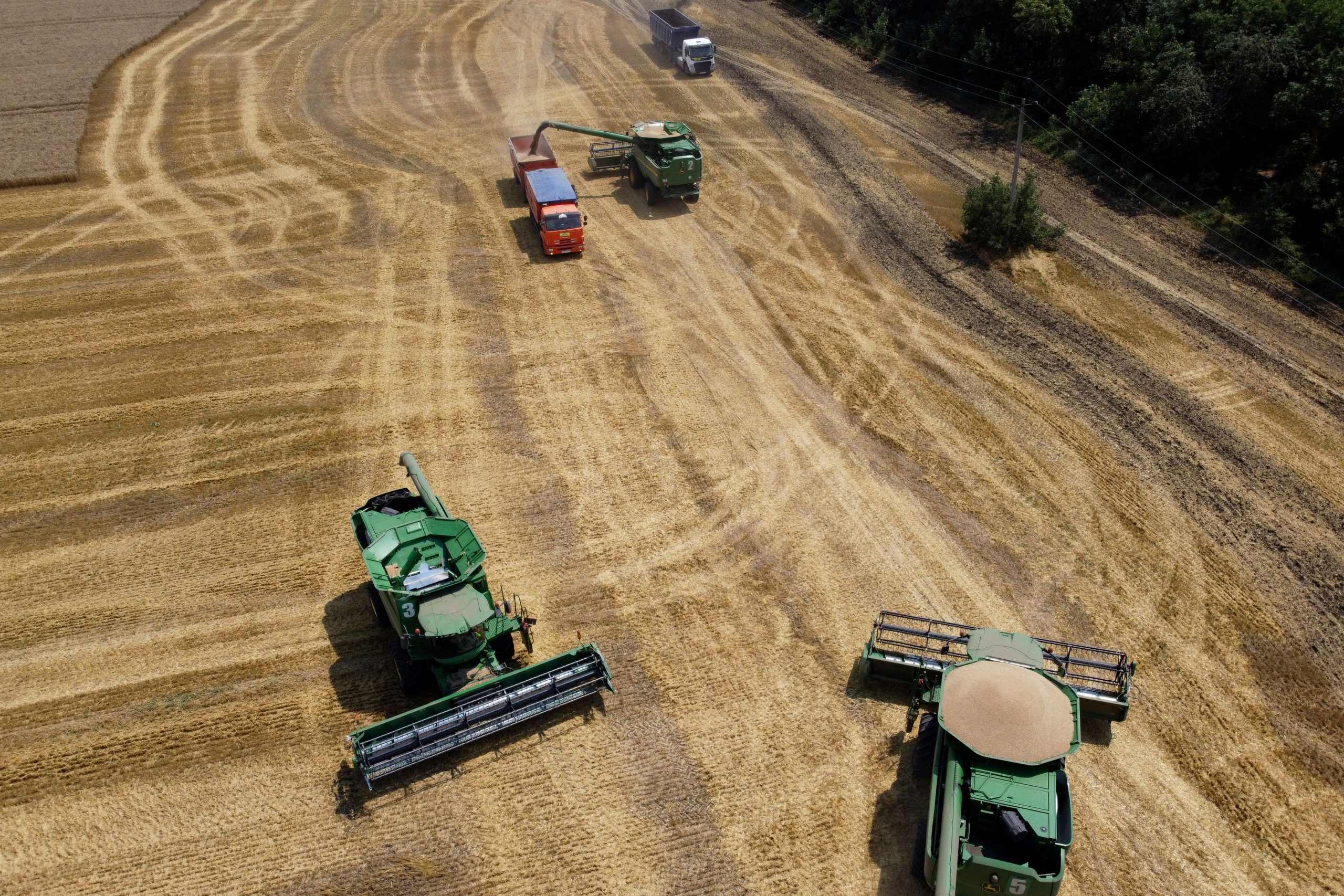India announced its decision, late Friday, to ban wheat export stating “food security” of the nation, “neighbouring countries and other vulnerable countries is at risk”.
With the war between Ukraine and Russia disrupting wheat supply, many countries had turned to India to fill the vacuum. However, New Delhi’s decision only exacerbates concerns of a global food crisis, considering the warring nations accounted for over 28% of wheat supply across the world.
UN Secretary-General Antonio Guterres noted earlier in May that the issue of food security wouldn’t be resolved until Ukrainian production returned to the market. However, Ukraine faces a massive hurdle in its wheat export, in the form of Russian blockades, and Moscow’s chokehold over the Black Sea ports that the nation formerly used to ship wheat to the world.
Also Read | A crisis averted: Why the world can run without Russian oil
With the ban on Indian wheat export and the price hike it will lead to, it becomes imperative for Ukraine to circumvent the Russian blockade and find alternate routes to export wheat. That is exactly what Kyiv has been trying to do through collaborations with other European nations and the European Union (EU).
However, there are a few logistical challenges, but Ukraine remains determined to send its wheat out, to help the world and itself.
The war that shook the wheat fields
Russian President Vladimir Putin sent troops into Ukraine on February 24, triggering a war that is still ongoing. Prior to the conflict, Ukraine was the sixth-largest wheat exporter in the world in 2021, accounting for 10% of the world’s market share, as per the United Nations (UN).
The conflict resulted in grain shipments including wheat, barley, and rye, being blocked from exiting Ukraine. Almost 25 million tons of grain are currently sitting unused, in the nation’s storage facilities, as per Food and Agriculture Organization economist Josef Schmidhuber.
Refinitiv, owned by the London Stock Exchange Group, has noted that up to 12 million tonnes of wheat slated for global exports face hurdles due to the Black Sea blockades.
Also Read | South Ossetia, Georgia’s breakaway region, sets vote to join Russia
Ukraine, which already planted 7 million hectares of crops for its summer harvest, already has its grain storage facilities filled to the capacity. If no tangible export solution is found, the nation will be unable to harvest these crops.
David Beasley, executive director of the World Food Programme, noted, “Right now, Ukraine’s grain silos are full”, adding, “At the same time, 44 million people around the world are marching toward starvation. We have to open up these ports so that food can move in and out of Ukraine”, as per AgWeb.
Wields the scythe of mass damnation
Since the start of the war, Russian attacks have targeted Ukraine’s port cities, both on the Azov and Black Seas. The nation, prior to the war, used its seven Black Sea ports to export grain.
Beasley noted, “I don’t see how the country does anything but collapses if the ports aren’t opened”, adding, “Farmers harvest in July and August. You really only have a matter of days — around 60 — to resolve this issue.”
However, attacks on Mykolaiv, where Ukrainian forces struggle to block Russia’s advances, and Moscow’s renewed attacks on Odesa, portray a grim reality that it’ll be some time before Kyiv can use its Black Sea ports for shipping purposes.
Also Read | Llyod Austin holds 1-hour call with Sergei Shoigu: What they discussed
Currently, Ukraine has two export terminals functional, Izmail and Reni, on the Danube river, but their capacity is nowhere close to Odesa’s.
In a video address, Ukrainian President Volodymyr Zelensky highlighted the situation, saying “For the first time in decades and decades, in Odesa there is no regular movement of the merchant fleet, there is no routine port work. This has probably never happened in Odesa since World War Two”, and added, “And this is a blow not only to Ukraine. Without our agricultural exports, dozens of countries in different parts of the world are already on the brink of food shortages. And over time, the situation can become, frankly, frightening.”
Earlier, too, Zelensky had urged on his Telegram channel “Immediate measures must be taken to unblock Ukrainian ports for wheat exports”.
Come together, right now
The Ukrainian government is already pursuing talks with neighbouring countries to circumvent the Russian blockades. Lithuania, Latvia, and Poland are all poised to help the war-torn country with Beasley of WFP adding “We’re running out of time and the cost of inaction will be higher than anyone can imagine. I urge all parties involved to allow this food to get out of Ukraine to where it’s desperately needed so we can avert the looming threat of famine”.
The possibility for Ukraine to ship grains through international ports was first floated by Latvian President Egils Levits, on April 13, during a joint briefing with counterparts from Ukraine, Poland, Lithuania, and Estonia.
Also Read | What did Olaf Scholz, Vladimir Putin discuss in their 75-minutes long phone call?
At the time, Levits said, “We talked with Mr Zelensky that Latvia can help export grain from Ukraine so that the flow could go through Latvian ports. We called our governments after the meeting and we will take further steps to make this effort a success”.
It gained popularity, with Ukraine’s Agrarian Policy and Food Minister Mykola Solskyi visiting Latvia on April 25 to examine this avenue. On April 29, Solskyi spoke to Polish and Lithuanian officials, and after some negotiations, the countries opened their ports for Ukrainian wheat to be exported.
“We put an offer on the table, if Ukraine wants, they can use it. They can use our seaports”, Polish President Andrzej Duda said in a Wall Street Journal interview.
Canadian President Justin Trudeau also offered to help Kyiv find solutions to export wheat, while European Council President Charles Michel wrote on Twitter after visiting Odesa, “This badly needed food is stranded because of the Russian war and blockade of Black Sea ports. Causing dramatic consequences for vulnerable countries. We need a global response”.
Shiny and contoured the railway winds
With Ukraine reaching a decision to export its wheat via international ports, there’s been an additional challenge. The nation needs to use railways to get the grain out of the country to its neighbours.
Russia has damaged sections of Ukraine’s railways but the war-torn nation has a greater logistical issue.
Ukraine’s track gauge – which is the distance between two rails – is wider (1.52m) than most of the other tracks in Europe (1.435m). This is because Ukraine shares Russian specifications for their tracks – a reminder of the time the nation was part of the erstwhile USSR.
Also Read | Is Russia failing to progress in Ukraine? Operation in rebel-held areas unsuccessful
This means Ukrainian grain must be unloaded at these countries’ borders and loaded onto carriages suited for the different tracks – a process which is both time-consuming and expensive.
While Lithuania and Latvia have the same track measurements as Ukraine, Poland follows a different set of specifications.
Lithuanian Agriculture Minister Kęstutis Navickas noted this in an April announcement about Ukraine’s partnership, saying “The potential of the port is of no doubt [but] railroad tracks may cause concern. In Poland, the gauge is narrower than in Ukraine, Lithuania, and Latvia”.
However, the Baltic railway system also has the hurdle of passing through Belarus – Russia’s ally – before accessing any ports.
Romania proposed opening up a disused Soviet-era railway line, connecting Ukraine, via Moldova, to its Danube River port city, Galati.
Also Read | Is Kyiv still a target for Russian forces?
Transport Minister Sorin Grindeanu set a May 19 deadline for rehabilitating this track and said “This rail line will enable the transporting of goods to and from Ukraine”, adding, “This Danube port will become, alongside the port of Constanta, one of the key places in the region for transporting goods and raw materials”, as per Reuters.
The Constanta choke and Poland’s allure
While Constanta has been Ukraine’s go-to option, the Romanian port is choking up due to the war. Odessa consultancy Informall, noted that this congestion is stifling grain exports as well.
Romania’s container yards are already functioning at capacity since the majority of Ukraine’s trade now flows through the Constanta port since Odesa and Mariupol are both besieged by Russian forces.
Informall explained, “each shipping line provides its own instructions and individual requirements for containers destined for Ukraine which makes it even more challenging for freight forwarders working in a state of war. While containers are dwelling at Constanta container yard, vessels keep bringing more import boxes into the port”, as reported by The Loadstar, a freight and logistics industry news outlet.
Also Read | Russia’s Bastion missiles in Ukraine: All you need to know
With Romania bottling up, Poland’s Gdynia and Gdansk ports on the Baltic Sea remain the next best options, especially with the expedited export of Ukrainian grains being a major point of concern.
“Transport stakeholders consider Polish ports an alternative gateway for Ukrainian ocean containers and various crops. Exports of crops are an essential part of the Ukrainian economy, as well as important for many consumers abroad”, Informall continued.
To overcome the problem of tracks, and ease the bottleneck at the Polish border – necessitated by the wagon swaps – Warsaw is looking for investors to build a dry port at the Ukraine-Poland border.
Also Read | What is in US Congress’ $40 billion aid package for Ukraine?
This would combine both gauges, and allow for freight trains to unload quicker. However, Informall feels this investment might be unattractive to EU investors, noting “Once Ukrainian sea ports are unblocked, millions of tonnes will flow via its grain terminals again. The spiked demand for rail service and warehouse space in Poland among Ukrainian exporters will roll back within a short time, making an investment unattractive for the EU investors.”
Just keep truckin’ on
While railways remain the easiest option, Ukraine is also exploring alternatives like transporting wheat by trucks. Andrii Deshchytsia, Ukraine’s ambassador to Poland, told the Wall Street Journal “It’s possible to deliver it by truck from Ukraine into Poland, that’s also a solution”.
EU’s plan to help Ukraine
The EU has decided to help Ukraine in its current plans to get wheat out of the country, noting it is sitting on almost 8 billion euros ($8.2 billion) worth of wheat that can’t be exported.
Adina Valean, European commissioner for transport said, “Twenty million tons of grains have to leave Ukraine in less than three months using the EU infrastructure”, adding, “This is a gigantesque challenge, so it is essential to coordinate and optimize the logistic chains, put in place new routes, and avoid, as much as possible, the bottlenecks”, as per Daily Sabah, a pro-Turkish government news outlet.
Also Read | How Elon Musk’s Starlink is fighting Putin in Ukraine
The European Commission, or the executive arm of the EU, is looking to increase exports via trucks and railways. Trains are already carrying grain to Germany and Austria via other EU nations, but the amount is a fraction of what Ukraine sent out through its ports.
The EU also has a plan to solve the congestion at borders, with an urgent use of additional transport vehicles including grain-hopper trailers, cargo containers, and barges and vessels.
The commission also noted that Ukraine’s ports on the Danube River can be put to greater use since all non-military flights are grounded due to the war.
Also Read | Odessa’s strategic importance to Russia in Ukraine invasion: Explained
The bloc also urged member nations to speed up procedures at border crossing points and increase capacity on EU soil to temporarily store Ukrainian exports.
It added, “In the medium to long term, the commission will also work on increasing the infrastructure capacity of new export corridors and on establishing new infrastructure connections”.
As Ukraine works in tandem with European nations to get its wheat to the world, India’s ban on wheat export only adds urgency to the process.







